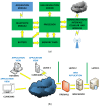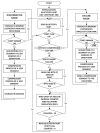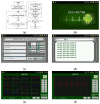A Flexible 12-Lead/Holter Device with Compression Capabilities for Low-Bandwidth Mobile-ECG Telemedicine Applications
- PMID: 30400587
- PMCID: PMC6264074
- DOI: 10.3390/s18113773
A Flexible 12-Lead/Holter Device with Compression Capabilities for Low-Bandwidth Mobile-ECG Telemedicine Applications
Abstract
In recent years, a number of proposals for electrocardiogram (ECG) monitoring based on mobile systems have been delivered. We propose here an STM32F-microcontroller-based ECG mobile system providing both long-term (several weeks) Holter monitoring and 12-lead ECG recording, according to the clinical standard requirements for these kinds of recordings, which in addition can yield further digital compression at stages close to the acquisition. The system can be especially useful in rural areas of developing countries, where the lack of specialized medical personnel justifies the introduction of telecardiology services, and the limitations of coverage and bandwidth of cellular networks require the use of efficient signal compression systems. The prototype was implemented using a small architecture, with a 16-bits-per-sample resolution. We also used a low-noise instrumentation amplifier TI ADS1198, which has a multiplexer and an analog-to-digital converter (16 bits and 8 channels) connected to the STM32F processor, the architecture of which incorporates a digital signal processing unit and a floating-point unit. On the one hand, the system portability allows the user to take the prototype in her/his pocket and to perform an ECG examination, either in 12-lead controlled conditions or in Holter monitoring, according to the required clinical scenario. An app in the smartphone is responsible for giving the users a friendly interface to set up the system. On the other hand, electronic health recording of the patients are registered in a web application, which in turn allows them to connect to the Internet from their cellphones, and the ECG signals are then sent though a web server for subsequent and ubiquitous analysis by doctors at any convenient terminal device. In order to determine the quality of the received signals, system testing was performed in the three following scenarios: (1) The prototype was connected to the patient and the signals were subsequently stored; (2) the prototype was connected to the patient and the data were subsequently transferred to the cellphone; (3) the prototype was connected to the patient, and the data were transferred to the cellphone and to the web via the Internet. An additional benchmarking test with expert clinicians showed the clinical quality provided by the system. The proposed ECG system is the first step and paves the way toward mobile cardiac monitors in terms of compatibility with the electrocardiographic practice, including the long-term monitoring, the usability with 12 leads, and the possibility of incorporating signal compression at the early stages of the ECG acquisition.
Keywords: Android™; ECG; Holter; STM32F microcontroller; rural areas; signal compression low-bandwidth; telemedicine.
Conflict of interest statement
The authors declare no conflict of interest.
Figures













Similar articles
-
Pit-a-Pat: A Smart Electrocardiogram System for Detecting Arrhythmia.Telemed J E Health. 2015 Oct;21(10):814-21. doi: 10.1089/tmj.2014.0187. Epub 2015 Aug 4. Telemed J E Health. 2015. PMID: 26241214
-
Telemedicine supported by Augmented Reality: an interactive guide for untrained people in performing an ECG test.Biomed Eng Online. 2014 Nov 21;13:153. doi: 10.1186/1475-925X-13-153. Biomed Eng Online. 2014. PMID: 25413448 Free PMC article.
-
A portable ECG monitoring device with Bluetooth and Holter capabilities for telemedicine applications.Conf Proc IEEE Eng Med Biol Soc. 2006;2006:5244-7. doi: 10.1109/IEMBS.2006.260798. Conf Proc IEEE Eng Med Biol Soc. 2006. PMID: 17946295
-
Toward personal eHealth in cardiology. Results from the EPI-MEDICS telemedicine project.J Electrocardiol. 2005 Oct;38(4 Suppl):100-6. doi: 10.1016/j.jelectrocard.2005.06.011. J Electrocardiol. 2005. PMID: 16226083 Review.
-
ECG by mobile technologies.J Electrocardiol. 2016 Nov-Dec;49(6):894-901. doi: 10.1016/j.jelectrocard.2016.07.030. Epub 2016 Jul 28. J Electrocardiol. 2016. PMID: 27524474 Review.
Cited by
-
Telemedicine maybe an effective solution for management of chronic disease during the COVID-19 epidemic.Prim Health Care Res Dev. 2021 Sep 29;22:e48. doi: 10.1017/S1463423621000517. Prim Health Care Res Dev. 2021. PMID: 34583801 Free PMC article. Review.
-
Application of Convolutional Neural Network for Decoding of 12-Lead Electrocardiogram from a Frequency-Modulated Audio Stream (Sonified ECG).Sensors (Basel). 2024 Mar 15;24(6):1883. doi: 10.3390/s24061883. Sensors (Basel). 2024. PMID: 38544146 Free PMC article.
-
Telecardiology in Rural Practice: Global Trends.Int J Environ Res Public Health. 2022 Apr 4;19(7):4335. doi: 10.3390/ijerph19074335. Int J Environ Res Public Health. 2022. PMID: 35410012 Free PMC article. Review.
-
Cardiovascular disease in the Americas: optimizing primary and secondary prevention of cardiovascular disease series: cardiovascular disease in the Americas.Lancet Reg Health Am. 2025 Feb 14;42:100964. doi: 10.1016/j.lana.2024.100964. eCollection 2025 Feb. Lancet Reg Health Am. 2025. PMID: 40034111 Free PMC article. Review.
References
-
- Cromwell L., Weibell F., Pfeiffer A. Biomedical Instrumentation and Measurements. Prentice Hall; Upper Saddle River, NJ, USA: 1980. pp. 49–52.
-
- Chan C.-C., Chou W.-C., Chen C.-W., Ho Y.-L., Lin Y.-H., Ma H.-P. Energy efficient diagnostic grade mobile ECG monitoring; Proceedings of the 2012 IEEE 10th International New Circuits and Systems Conference; Montreal, QC, Canada. 17–20 June 2012; pp. 153–156.
-
- Gradl S., Kugler P. Real-time ECG monitoring and arrhythmia detection using Android™-based mobile devices; Proceedings of the 2012 Annual International Conference of the IEEE Engineering in Medicine and Biology Society; Piscataway, NJ, USA. 28 August–1 September 2012; pp. 2452–2455. - PubMed
MeSH terms
LinkOut - more resources
Full Text Sources
Medical

